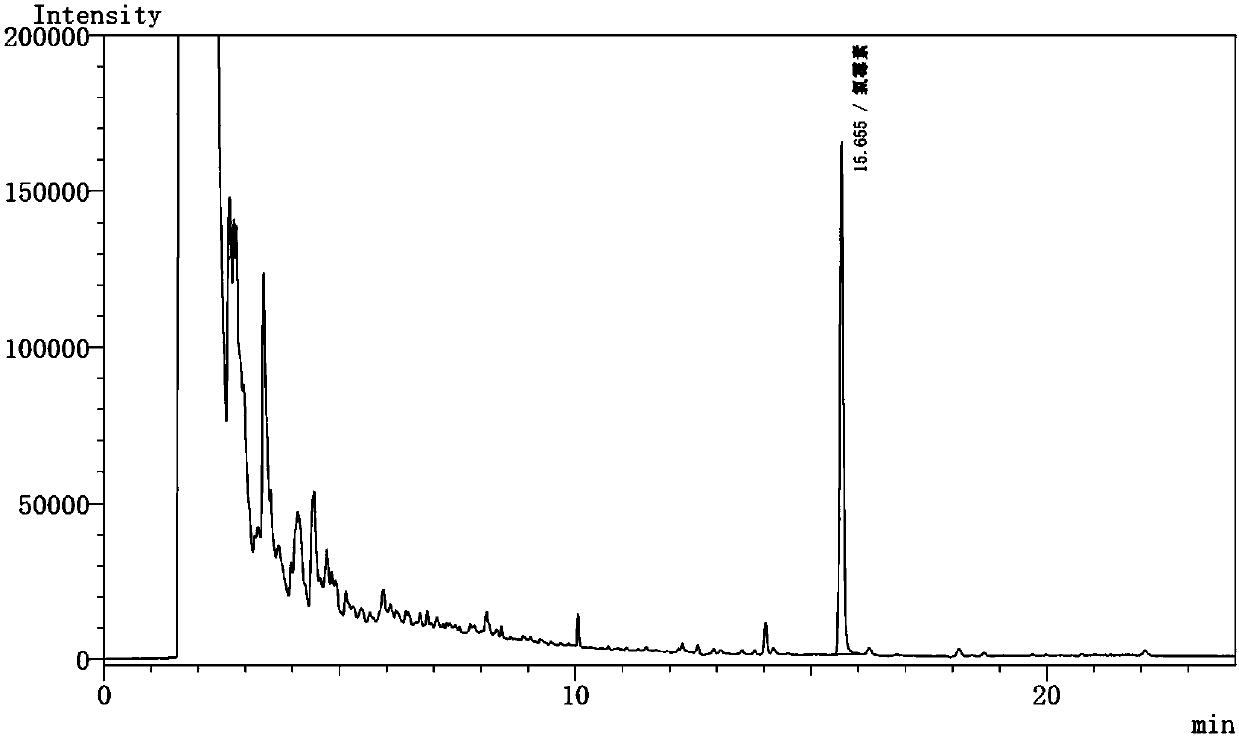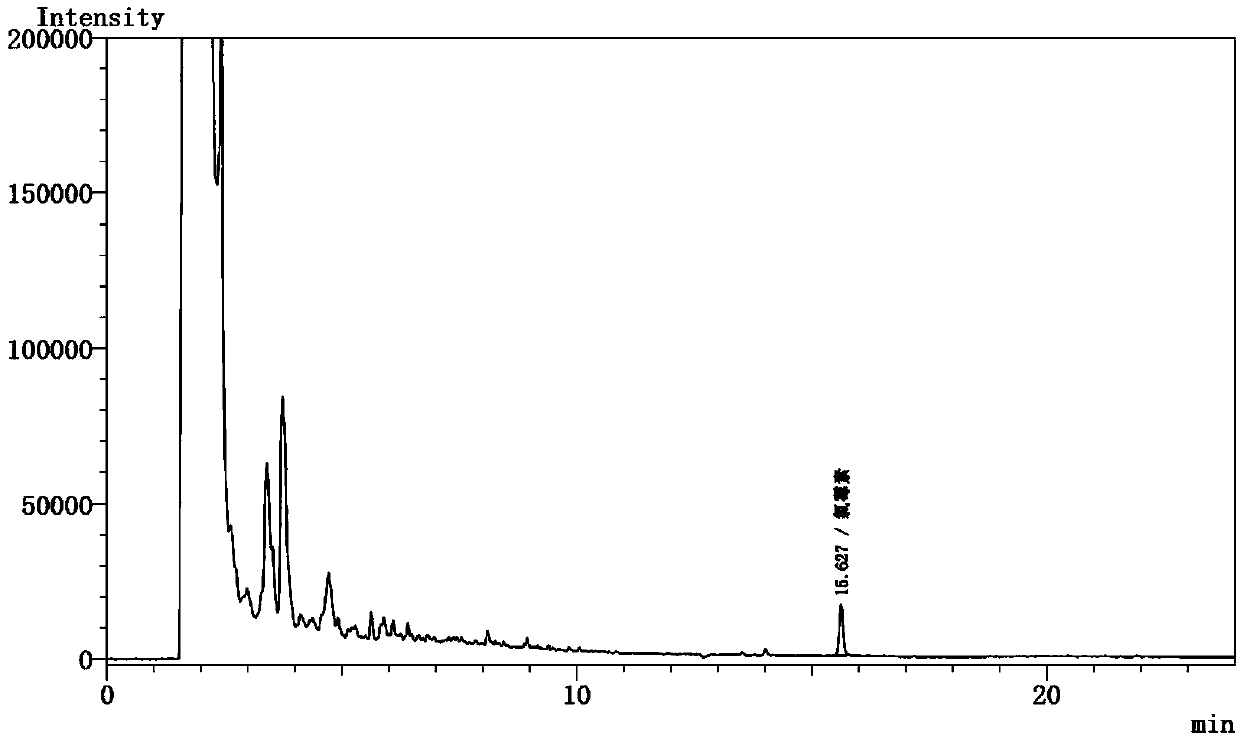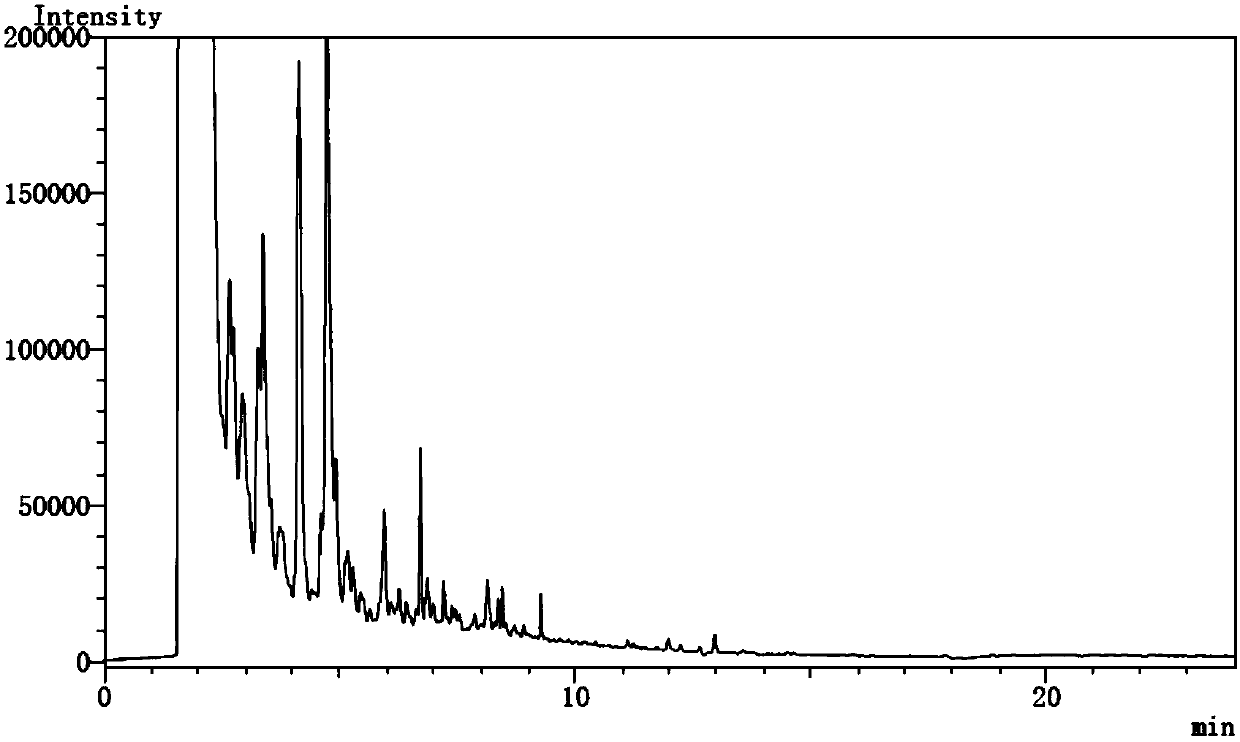A kind of detection method of residual amount of chloramphenicol
A detection method and residue technology, applied in the direction of measuring devices, instruments, scientific instruments, etc., can solve the problems of humidity sensitivity, harm, and impact measurement, and achieve the effect of low sensitivity
- Summary
- Abstract
- Description
- Claims
- Application Information
AI Technical Summary
Problems solved by technology
Method used
Image
Examples
Embodiment 1
[0043] A kind of detection method of chloramphenicol residue, comprises the steps:
[0044] 1) Sample pretreatment: Take the aquatic product shrimp to be tested, take 5g of the muscle part and put it in a centrifuge tube, add 20mL of ethyl acetate, homogenize it with a homogenizer for 1min to make a homogenate, centrifuge at 4000r / min for 3min, and dissolve the ethyl acetate Transfer the ester layer to a thin-necked heart-shaped bottle; then add 10 mL of ethyl acetate to the centrifuge tube, homogenize for 1 min, centrifuge at 4000 r / min for 3 min, combine the ethyl acetate extract, and evaporate under reduced pressure in a water bath at 40 °C to dryness;
[0045] 2) Purification of the sample: Dissolve the extract obtained by evaporation in a water bath in step 1) in 1 mL of methanol, add 15 mL of n-hexane and 25 mL of 4% sodium chloride solution in turn, shake and mix for 1 min, then transfer to a centrifuge tube, 4000 r / min Centrifuge for 2 min, discard the upper n-hexane p...
Embodiment 2
[0051] A kind of detection method of chloramphenicol residue, comprises the steps:
[0052] 1) Sample pretreatment: Take the aquatic product shrimp to be tested, take 5g of the muscle part and put it in a centrifuge tube, add 20mL of ethyl acetate, homogenize it with a homogenizer for 1min to make a homogenate, centrifuge at 4000r / min for 3min, and dissolve the ethyl acetate Transfer the ester layer to a thin-necked heart-shaped bottle; then add 10 mL of ethyl acetate to the centrifuge tube, homogenize for 1 min, centrifuge at 4000 r / min for 3 min, combine the ethyl acetate extract, and evaporate under reduced pressure in a water bath at 40 °C to dryness;
[0053] 2) Purification of the sample: Dissolve the extract obtained by evaporation in a water bath in step 1) in 1 mL of methanol, add 15 mL of n-hexane and 25 mL of 4% sodium chloride solution in turn, shake and mix for 1 min, then transfer to a centrifuge tube, 4000 r / min Centrifuge for 2 min, discard the upper n-hexane p...
Embodiment 3
[0059] A kind of detection method of chloramphenicol residue, comprises the steps:
[0060] 1) Sample pretreatment: Take the aquatic product shrimp to be tested, take 5g of the muscle part and put it in a centrifuge tube, add 20mL of ethyl acetate, homogenize it with a homogenizer for 1min to make a homogenate, centrifuge at 4000r / min for 3min, and dissolve the ethyl acetate Transfer the ester layer to a thin-necked heart-shaped bottle; then add 10 mL of ethyl acetate to the centrifuge tube, homogenize for 1 min, centrifuge at 4000 r / min for 3 min, combine the ethyl acetate extract, and evaporate under reduced pressure in a water bath at 40 °C to dryness;
[0061]2) Purification of the sample: Dissolve the extract obtained by evaporation in a water bath in step 1) in 1 mL of methanol, add 15 mL of n-hexane and 25 mL of 4% sodium chloride solution in turn, shake and mix for 1 min, then transfer to a centrifuge tube, 4000 r / min Centrifuge for 2 min, discard the upper n-hexane ph...
PUM
| Property | Measurement | Unit |
|---|---|---|
| length | aaaaa | aaaaa |
| thickness | aaaaa | aaaaa |
| recovery rate | aaaaa | aaaaa |
Abstract
Description
Claims
Application Information
 Login to View More
Login to View More - R&D
- Intellectual Property
- Life Sciences
- Materials
- Tech Scout
- Unparalleled Data Quality
- Higher Quality Content
- 60% Fewer Hallucinations
Browse by: Latest US Patents, China's latest patents, Technical Efficacy Thesaurus, Application Domain, Technology Topic, Popular Technical Reports.
© 2025 PatSnap. All rights reserved.Legal|Privacy policy|Modern Slavery Act Transparency Statement|Sitemap|About US| Contact US: help@patsnap.com



